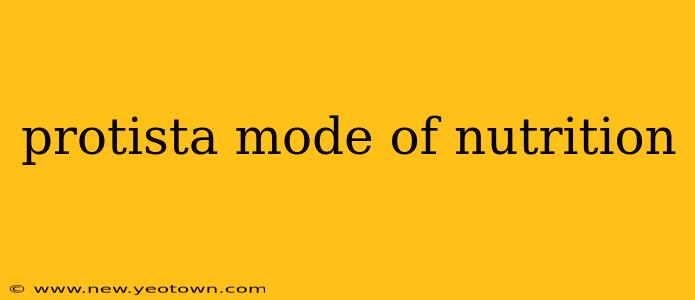The Protista kingdom is a sprawling, diverse group of eukaryotic organisms – think of them as the evolutionary crossroads between bacteria and the more complex plants, animals, and fungi. This diversity extends to their modes of nutrition, which are as varied and fascinating as the organisms themselves. Forget the neat boxes of "producer" or "consumer" – protists defy easy categorization, displaying a stunning array of feeding strategies.
Let's dive into this fascinating world and unravel the mysteries of protist nutrition. We'll explore various methods and answer some common questions along the way.
What are the different types of protist nutrition?
Protists exhibit a remarkable range of nutritional strategies, including:
-
Photoautotrophic: These protists, much like plants, are capable of producing their own food through photosynthesis. Imagine microscopic algae, like diatoms and dinoflagellates, harnessing the sun's energy to create sugars. They are the foundation of many aquatic food webs. Their vibrant colors often paint the oceans and lakes in stunning hues.
-
Heterotrophic: These protists obtain their nutrients by consuming other organisms or organic matter. This is a vast category, with numerous sub-strategies.
-
Mixotrophic: Some impressively adaptable protists combine both photoautotrophic and heterotrophic modes. They can photosynthesize when sunlight is abundant but switch to consuming other organisms when conditions change. This adaptability allows them to thrive in unpredictable environments.
How do heterotrophic protists obtain nutrients?
Heterotrophic protists display a remarkable variety of feeding mechanisms:
-
Ingestion: Many protists, like amoebas, engulf their food through phagocytosis. Imagine a tiny, single-celled creature extending pseudopods (temporary extensions of the cytoplasm) to surround and consume bacteria, algae, or even other protists. It's a mesmerizing ballet of cellular movement and predation.
-
Absorption: Other protists, particularly those that are parasitic or saprobic, absorb dissolved organic matter from their surroundings. Imagine a microscopic scavenger, quietly breaking down decaying organic matter and absorbing the nutrients released in the process. This is crucial for nutrient cycling in ecosystems.
-
Parasitism: Some protists are parasitic, meaning they live on or within a host organism, deriving nutrients at the host's expense. Think of the Plasmodium species, which cause malaria—a devastating disease affecting millions worldwide.
What are some examples of protists and their nutrition?
Let's look at some specific examples to solidify our understanding:
-
Paramecium: This single-celled protist is a classic example of a heterotroph, utilizing cilia (hair-like structures) to sweep food particles into an oral groove, where they are then digested.
-
Euglena: A fascinating mixotroph, Euglena possesses chloroplasts and can photosynthesize, yet can also absorb nutrients from its environment when light is scarce. This impressive adaptability illustrates the evolutionary flexibility of protists.
-
Amoeba: A quintessential example of a heterotrophic protist that feeds by phagocytosis, engulfing its prey with pseudopods.
What role do protists play in ecosystems?
Protists play vital roles in maintaining the balance of ecosystems:
-
Primary Producers: Photoautotrophic protists, like phytoplankton, form the base of many aquatic food webs, providing energy for countless other organisms.
-
Decomposers: Saprobic protists play crucial roles in decomposition, breaking down organic matter and recycling nutrients.
-
Symbionts: Some protists form symbiotic relationships with other organisms, with mutual benefits for both partners. Examples include the algae residing within corals, providing them with vital nutrients.
Are all protists microscopic?
While many protists are microscopic, some can reach macroscopic sizes, like certain types of kelp, which are actually giant protists.
Protists, with their diverse and ingenious feeding strategies, are essential components of countless ecosystems. Understanding their nutritional adaptations allows us to better appreciate the intricate web of life on Earth. From the microscopic algae sustaining aquatic life to the parasites causing devastating diseases, protists continue to fascinate and challenge our understanding of the biological world.

